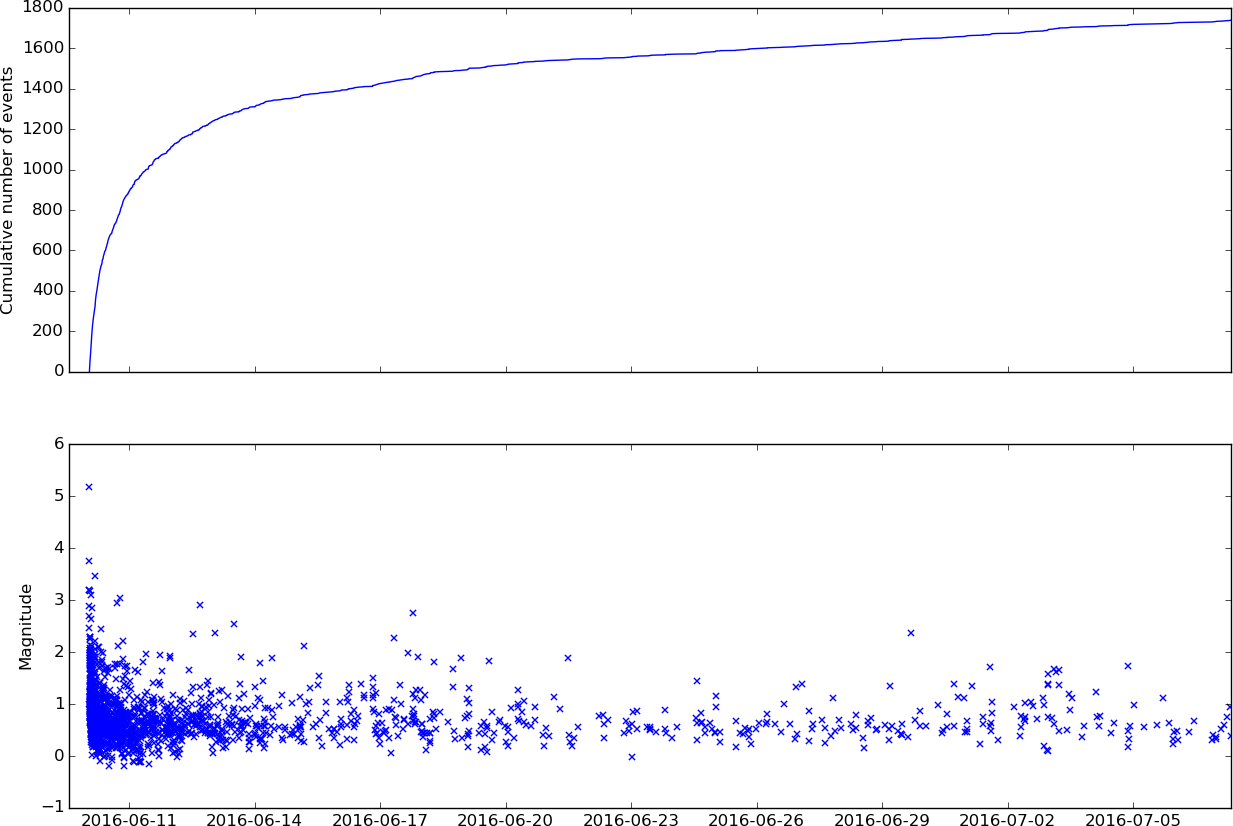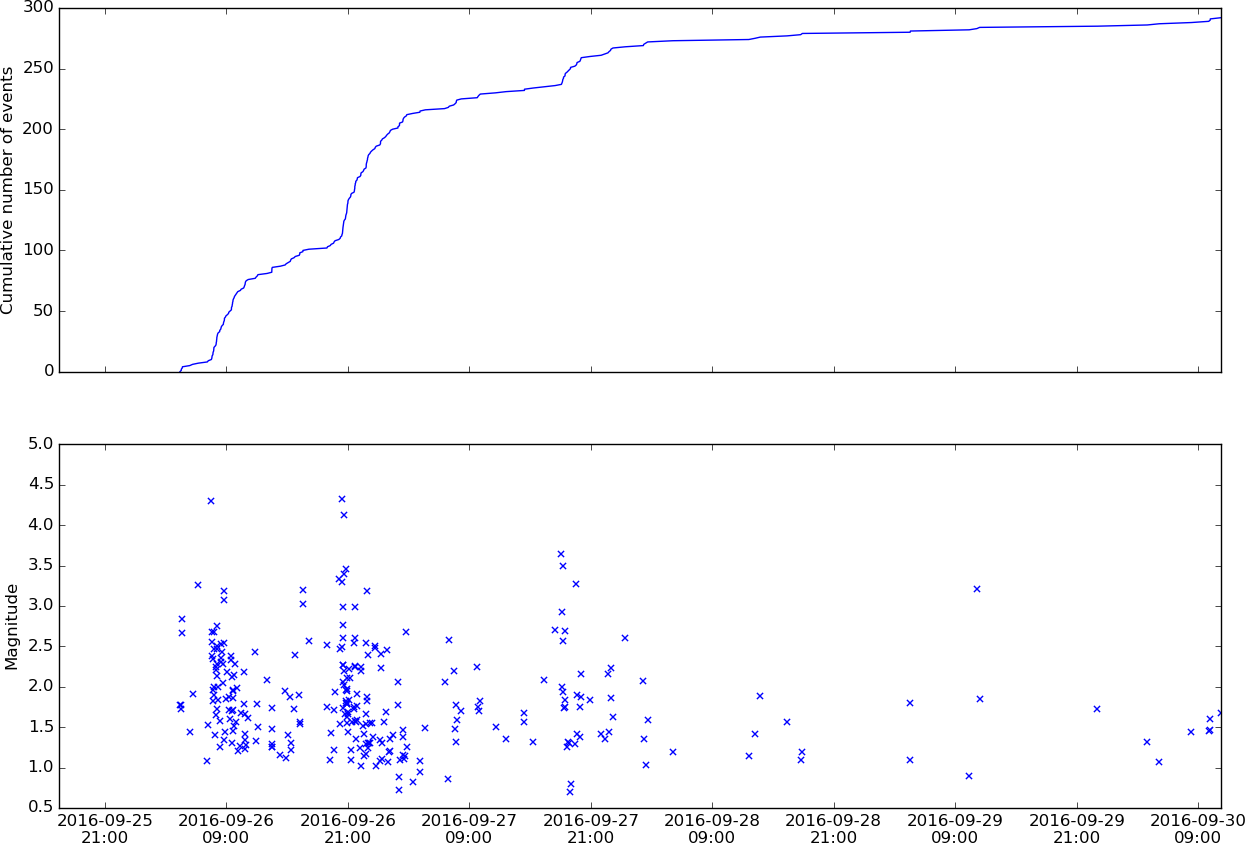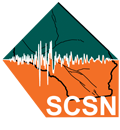To quote the USGS Earthquake Hazards Program, a seismic swarm is “A series of minor earthquakes occurring in the same area and time, none of which may be identified as the main shock”.
- What is a swarm?
- Where do we see swarms in Southern California?
- Why do swarms occur?
- Why do we monitor them?
- Where else do we see swarms around the world?
- Notable swarms within our network
The map shows a number of regions that are being monitored for earthquake swarms. Click on the region to see the name given, which will also appear in automatic swarm notifications. Regions outlined in orange have experienced events during the previous day.
The maps show a 1-day period of events within the six regions that are currently being monitored for earthquake swarms. Events for each region are updated each day at 5pm. Click within the maps on the region or individual events to be taken to the 7-day USGS interactive earthquake pages for further information.
Brawley-Seismic |
Salton-Buttes |
Lavic-Lake |
Coso |
Golden-Trout |
Ubehebe |
What is a swarm?
As quoted above from the USGS Earthquake Hazards Program, a seismic swarm is “A series of minor earthquakes occurring in the same area and time, none of which may be identified as the main shock”.
This definition can best be understood as a distinction between a classic mainshock-aftershock sequence and a swarm. Seismologists study the characteristic patterns of seismicity to help understand the underlying behaviour of earth structures and the forces generating earthquakes. From this, various empirical rules have been determined which describe, for example, the magnitude, number and rate of events during aftershock sequences, and this helps us to understand stresses within the earth. The clearest way to show the comparison is by seeing plots of events over time for a classic mainshock-aftershock sequence (Borrego Springs 2016) and a swarm (Bombay Beach 2016).


By comparing the two sets of graphs it is apparent that swarms are a cluster of earthquakes occurring close together in time and space with no single distinguishable mainshock. Swarms are not defined as having any particular characteristics, and may vary significantly in their magnitude and rate, total event numbers, duration and other features.
Where do we see swarms in Southern California?
Swarms in Southern California can happen anywhere that normal seismicity is observed. That being said, certain areas, such as volcanic, hydrothermal, and complexly faulted regions have a higher tendency to produce swarms. These swarms are generally thought to be caused by a cascade of elastic fault rupture, fluid intrusion, or volcanic influence (Vidale and Shearer, 2006).
Common areas for swarms within our network include the region of Coso, Anza and Brawley.
Why do swarms occur?
While the direct cause of any particular swarm may not be completely understood, swarms are typically thought to occur due to one or a combination of three different mechanisms:
These factors can potentially act independently or in conjunction with each other in a wide range of tectonic environments to create earthquake swarms, only indicating that a swarm sequence is in the location of an “underlying geophysical disturbance” (Vidale and Shearer, 2006).
Why do we monitor them?
We regularly record swarms, simply because we monitor all of the earthquakes in Southern California. We specifically monitor the swarm locations indicated on this page because they are areas of potential and past volcanic activity. Because of the close relationship between swarms and magmatic intrusion it is important to monitor the seismicity in these areas as an indication of the potential onset of volcanic activity. This is also why volcanic observatories around the world primarily monitor earthquake activity; for example visit the Pacific Northwest Seismic Network website to see their plot of earthquakes near volcanoes across Oregon and Washington, or earthquakes recorded by the Hawaii Volcano Observatory.
Where else do we see swarms around the world?
Swarms can occur in almost all tectonic and volcanic environments. Most faults that generally produce classic foreshock-mainshock-aftershock sequences can produce the occasional swarm if the conditions are right. In regions where swarms happen without the presence of major faulting, fluid pressure and magmatic processes can be a cause. So, while swarms can happen anywhere in the world, there are places where the conditions are right for them to be more common.
Notable swarms within our network
- Cahuilla Swarm (2016-present): This swarm is interesting for a number of reasons, including being currently the most prolific and long-lasting in the region. Over 6,000 earthquakes have been recorded in the Cahuilla Swarm as of September 2018. It began with only a low rate and small magnitude earthquakes in mid-2016; over time the event rate has increased and SCSN has often recorded over 100 events per week. Most events are small and unfelt, but the largest event so far has been M4.4. The swarm is relatively small in extent, an almost linear feature of about 5 miles length, and is not occurring on a major fault, but lies between the San Jacinto and Elsinore fault zones. Click here for more information
- Brawley 2016: The Bombay Beach/Brawley swarm was notable because it is near the southern terminus of the San Andreas fault, raising concerns for activity on the San Andreas, although the swarm events themselves occurred on faults orthogonal to the San Andreas in a zone underlying the Salton Sea referred to as the Brawley Seismic Zone. The sequence contained three main clusters of activity, which look a little like small mainshock-aftershock sequences occurring close in time to each other. However, as there was no single mainshock, it is considered a swarm. Click here for more information
- Fillmore 2015: Fillmore was a notable swarm due to the relatively low seismicity common to the region and that the events indicated that there was possible fluid movement along a major fault in the region causing the swarm. Click here for more information
- Baja 2008: The Baja swarm near the California Mexico border was notable due to its numerous larger events located in a hydrothermal field relatively close to several large, potentially damaging faults such as the San Jacinto, Cerro Alto, and Imperial faults. Click here for more information
References
- Stein, R.S. (1999). The role of stress transfer in earthquake occurrence, Nature, 402, 605-609.
- Vidale, J.E., and P.M. Shearer (2006). A survey of 71 earthquake bursts across southern California: Exploring the role of pore fluid pressure fluctuations and aseismic slip as drivers, J. Geophys. Res., 111, B05312, doi:10.1029/2005JB004034.



